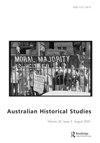《梦想家与阴谋家:澳大利亚政治史
IF 0.6
3区 历史学
Q1 HISTORY
引用次数: 1
摘要
特别是在这个问题上,关于如何探索人们的选择,并重建这些选择产生和限制的背景。吉布森令人心酸地唤起了我们在书中遇到的许多土著居民正在经历的危机感——一种深切的担忧,即他们所拥有的知识将如何传承下去,并被带到一个似乎远未确定的未来。斯特雷洛的档案,像许多公开的历史收藏一样,浓缩了它的“共同创造者”正在努力应对的情况:他们的知识将被保存下来的赌博,即使它远离记录它的地方,并与那些慷慨地分享它的人分离。吉布森的书之所以如此有价值,是因为它开始了重新连接收藏和“社区”的重要工作,当时他仍然可以利用当地和家庭对人们、地方和“记录”的实践的记忆。这让我想到了吉布森在处理Strehlow的档案时所做的第二个创新:他决定关注Strehlow在Anmatyerr上所做的工作。更常见的是,对Strehlow档案进行挖掘,以获取它所包含的arrnte知识。对吉布森来说,这不是一个抽象的或纯粹的智力决定:它源于他与Anmatyerr已经建立的关系,他意识到他们自己对收藏的浓厚兴趣,以及这些关系提供的机会,可以通过另一扇门进入档案馆,而不需要向Strehlow本人致敬那么多。由于他自己的立场,吉布森可以和人们一起阅读这些材料,他们的问题、好奇心、承诺和知识重新焕发了它的意义,并打开了它的可能性。通过这一缓慢的、相互关联的研究过程,吉布森创造了一个完全引人注目的早期人种学及其产品的人种学。在这一点上,他的书与近期采用类似方法的著名历史著作有一些共同之处,比如莎妮·帕尔默的《摧毁安格斯·唐斯》和蒂芙尼·谢拉姆的《遇见韦洛人》。通过这种有基础的、本地化的、合作的、关系的、与有价值的、不透明的收藏的接触,吉布森为一个不断增长的学术机构提供了另一个开创性的案例研究,这个学术机构坚持合作、相互关系和尊重地研究历史收藏和档案,仔细关注许多人的机构和背景,包括那些迄今为止一直被隐藏的贡献。以及它们对作为遗产的人民和社区所代表的当代挑战和机遇。本文章由计算机程序翻译,如有差异,请以英文原文为准。
Dreamers and Schemers: A Political History of Australia
ticularly on this question about how to plumb people’s choices and reconstruct the contexts within which those choices were created and circumscribed. Poignantly, Gibson evokes the sense of crisis thatmanyof theAboriginalmenwemeet in the book were experiencing – a deeply-felt concern about how the knowledge they possessed would be passed on and carried forward into a future that seemed far from certain. Strehlow’s archive, like many publicly held historical collections, encapsulates the situation that its ‘co-creators’ were grappling with: the gamble that their knowledge would be preserved even as it was distanced from the places where it was recorded and dissociated from those who so generously shared it. What makes Gibson’s book so valuable is that it commences the vital work of reconnecting collections and ‘communities’ at a time when he can still draw upon living local and family memories about the people, places, and practices it ‘documents’. This brings me to the second innovation that Gibson makes in approaching Strehlow’s archive: his decision to focus on the work that Strehlow did with the Anmatyerr. More usually, the Strehlow archive is mined for the Arrernte knowledge it holds. This was not an abstract or purely intellectual decision on Gibson’s part: it grew out of the relationships that he already had with Anmatyerr, his awareness of their own deep interest in the collection, and the opportunity that those relationships provided to enter the archive through a different door that did not demand quite so much homage to Strehlow himself. Because of his own grounding in place, Gibson can read the material alongside the people whose questions, curiosity, commitment and knowledge revivify its meaning and open up its possibilities. Through this process of slow, relational research, Gibson creates a thoroughly striking ethnography of an earlier ethnography and its products. On that score, his book has something in common with notable recent histories that take a similar approach, such as Shannyn Palmer’s Unmaking Angus Downs and Tiffany Shellam’s Meeting the Waylo. Through this grounded, localised, collaborative and relational encounter with a valuable, if opaque, collection, Gibson contributes another seminal case study to a growing body of scholarship that insists upon working collaboratively, relationally and respectfully on historical collections and archives, paying careful attention to the agency and contexts of the many people who made them, including those whose contribution has hitherto been hidden, and the contemporary challenges and opportunities they represent for the people and communities whose inheritances they are.
求助全文
通过发布文献求助,成功后即可免费获取论文全文。
去求助
来源期刊

AUSTRALIAN HISTORICAL STUDIES
HISTORY-
CiteScore
0.70
自引率
16.70%
发文量
86
期刊介绍:
Australian Historical Studies is a refereed journal dealing with Australian, New Zealand and Pacific regional issues. The journal is concerned with aspects of the Australian past in all its forms: heritage and conservation, archaeology, visual display in museums and galleries, oral history, family history, and histories of place. It is published in March, June and September each year.
 求助内容:
求助内容: 应助结果提醒方式:
应助结果提醒方式:


